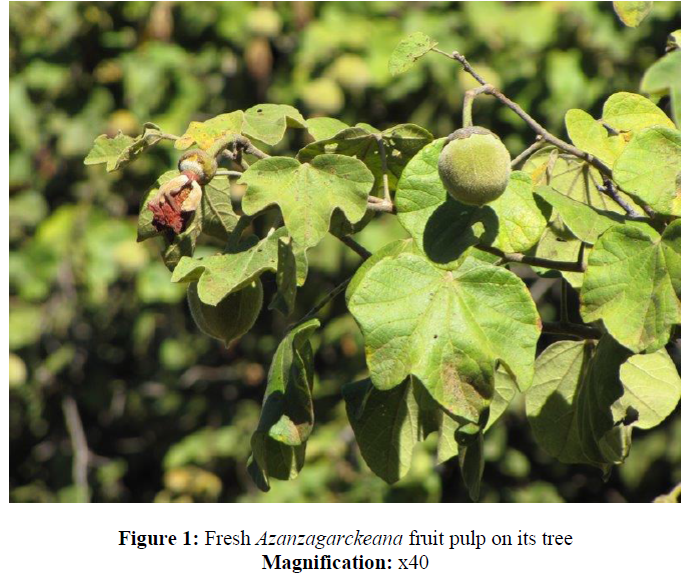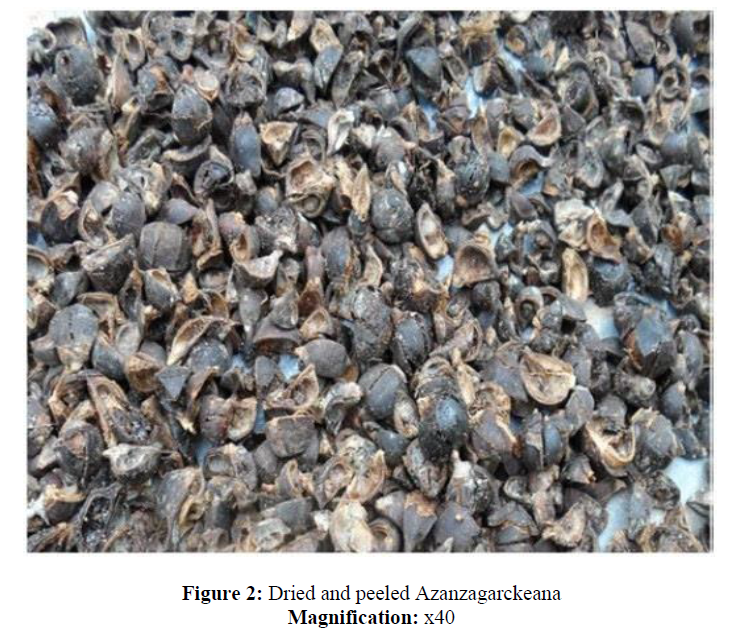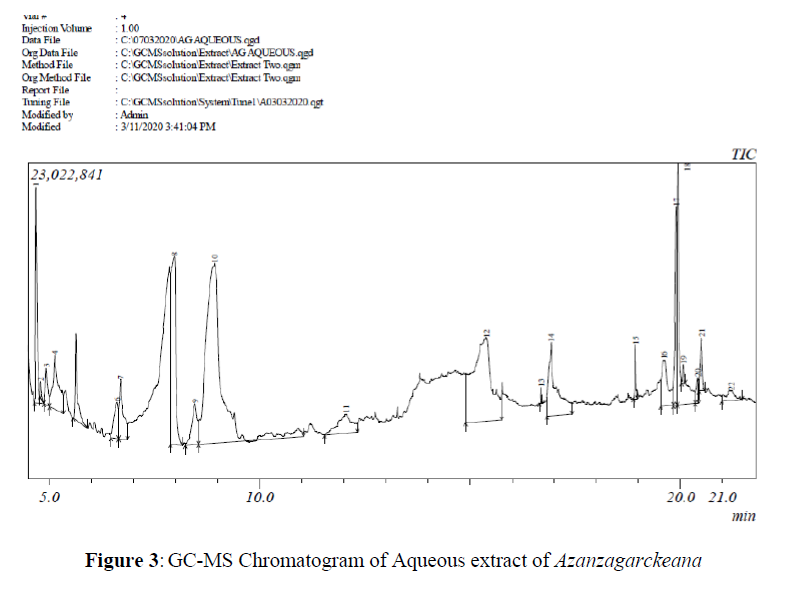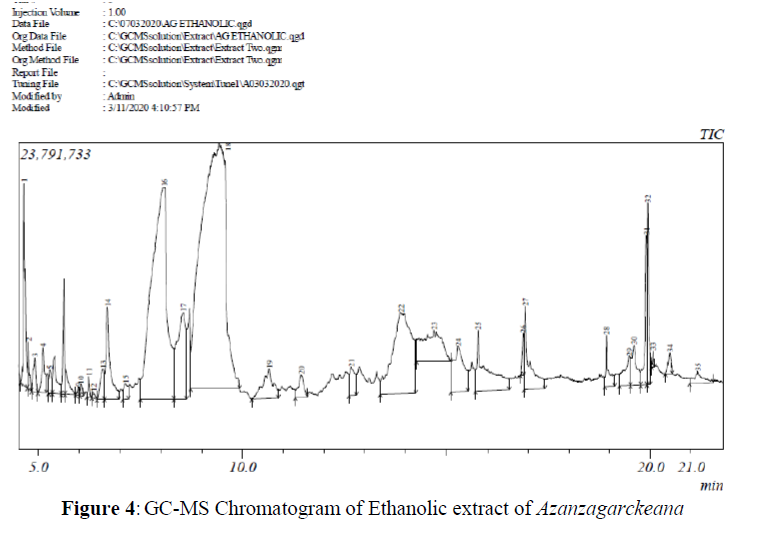Research Article - Der Pharma Chemica ( 2022) Volume 14, Issue 5
Gc-Ms Analysis of Bioactive Compounds on Aqueous and Ethanolic Extracts of Azanza Garckeana Fruit Pulp
John, H.1, Egbebi, A.O.1, Balami, A.G2 and Muhammad A.A.1*2Department of Veterinary Medicine, University of Maiduguri, Nigeria
Muhammad A.A., Department of Biological Science, Afe Babalola University, Ado-Ekiti, Ekiti State, Nigeria, Email: abdallahmuhd@yahoo.com
Received: 27-Apr-2022, Manuscript No. dpc-22-62015; Editor assigned: 29-Apr-2022, Pre QC No. dpc-22-62015; Reviewed: 13-May-2022, QC No. dpc-22-62015; Revised: 16-May-2022, Manuscript No. dpc-22-62015; Published: 23-May-2022, DOI: 10.4172/0975-413X.14.5.16-23
Abstract
A novel Gas Chromatography-Mass Spectrometry (GCMS) analysis of aqueous and ethanolic extract of Azanzagarckeanafruit pulp was carried out to identify the composition and percentage abundance of various phytochemicals. GC-MS analysis revealed the presence of 22 compounds in aqueous extract and 35 compounds in its ethanol extract among which had few similarity in compounds such as 2-Furanmethanol and 5-hydroxymethylfurfural (HMF). Some fatty acids and volatile organic acids were identified.Keywords
GC-MS; Azanzagarckeana; Compounds; Bioactive; Phytochemical
Introduction
There has been renewed interest in herbal remedies in several parts of the world with many of the herbal remedies being incorporated into orthodox medical practice. Some African countries: Egypt, Burkina Faso, Ghana, Nigeria, Zambia and South Africa have also made good advances in the area of the use of plants for production of new drugs [1]. In many tropical countries, rural dwellers traditionally harvest wide range of leafy vegetables, roots, tubers, and fruits from the wild as food supplements, spices, and sometimes for cultural uses. Labeled as famine or hunger food, some wild plants have been recognized to have the potentials to meet household food and income security [2]. The indigenous fruits collected from the wild plays a significant role in food and nutrient security of the poor and rural dwellers. Some wild fruits have been identified to have better nutritional value than cultivated fruits [3]. As a result, in recent years, a growing interest has emerged to evaluate various wild edible plants for their nutritional features [4].
Goron Tula (Hausa), having the botanical name, A. garckeana and known as African chewing gumis a valuable edible indigenous fruit tree. In northern Nigeria, the plant is found predominantly in Tula area of Kaltungo local government area of Gombe State, Kali hills of Zah district of Michika local government area of Adamawa State and available in most of the Northeast markets especially in rural areas. A. garckeana belong to a family malvaceae, which is the distrimotive family to which the hibiscus belongs. Most of the malvaceae in Nigeria are shrubs. A. garckeana is a semi-deciduous tree/shrub with a round medium crooked stem [5]. The tree can grow to a height of 3-15 meters depending on the environment in which it is grows [5], FAO (1982) reported that Azanzagarckeana grows naturally in semi-arid areas receiving lowest annual rain fall of 250 mm and height rain fall of 1270 mm. The mean annual rain fall is between 250 mm to 500 mm with attitude of 0 – 1900 m. The twigs are hairy when young but become smooth with age and branches have wooly hairs according to World Agroforestry (1992). The leaves are distinctively round with 8 to 12 cm long stalks. The leaves have 3 to 5 lobes, which are covered in brown star-shaped hairs, and have longitudinal fissures in the midrib (FAO, 1983). The flowers have many stamens and 5 petals, which are yellow or purplish in colour with dark purple or dark red Centre. The flowers are bisexual with all floral parts in fives. It flowers in wet season and fruits in dry season (April-August) (FAO, 1983) [6,7]. The fruits are hairy, spherical, hard and about 2.5 – 4 cm long in diameter, internally divided into 4 to 5 longitudinal sections, the fleshy gummy pulp which is generally eaten are a good source of proteins, minerals, fiber, vitamins, and contains five seeds inside with a seed in each segment. The seed is hemispherical in shape, up to 10mm long, 7mm thick with brownish and woolly floss [8]. They are yellowish to brownish green when mature (Figures 1,2).
Phytochemicals (from the Greek word phyto, meaning plant) are biologically active, naturally occurring chemical compounds found in plants, which provide health benefits for humans further than those attributed to macronutrients and micronutrients [9]. Plants are able to produce a large number of diverse bioactive compounds. High concentrations of phytochemicals, which may protect against free radical damage, accumulate in fruits and vegetables [10]. Plants containing beneficial phytochemicals may supplement the needs of the human body by acting as natural antioxidants [11]. A knowledge of the chemical constituents of plants is desirable not only for the discovery of therapeutic agents, but also because such information may be of great value in disclosing new sources of economic phytocompounds for the synthesis of complex chemical substances and for discovering the actual significance of folkloric remedies [12]. Hence a thorough validation of the herbal drugs has emerged as a new branch of science emphasizing and prioritizing the standardization of the natural drugs and products because several of the phytochemicals have complementary and overlapping mechanism of action. Mass spectrometry, coupled with chromatographic separations such as Gas chromatography (GC/MS) is normally used for direct analysis of components existing in traditional medicines and medicinal plants.
Gas chromatography has a very wide field of applications. But, its first and main area of use is in the separation and analysis of multi component mixtures such as essential oils, hydrocarbons and solvents. Intrinsically, with the use of the flame ionization detector and the electron capture detector (which have very high sensitivities) gas chromatography can quantitatively determine materials present at very low concentrations. It follows, that the second most important application area is in pollution studies, forensic work and general trace analysis. Because of its simplicity, sensitivity, and effectiveness in separating components of mixtures, gas chromatography is one of the most important tools in chemistry. It is widely used for quantitative and qualitative analysis of mixtures, for the purification of compounds, and for the determination of such thermo chemical constants as heats of solution and vaporization, vapor pressure, and activity coefficients.
Methods
Collection and extraction of Plant Samples
Fruit pulps were gotten from Tula, Kaltingo L.G.A of Gombe State, Northern Nigeria by August 2019 by hand plucking from the tree. The fruit was air dried for a month after opening and then oven dried in the laboratory at 40ºC. It was subsequently pulverized using hammer type milling machine (Meecan, CM/L-1364548, India). The powdered material was dissolved in ethanol of analytical grade for 72 h and in water for 48 h. It was filtered with a muslin cloth and the ethanolic extract concentrated using a rotary evaporator (RE300). Both extracts were then placed in water bath set at 40ºC [13]. The resultant product is a Jelly like substance which was placed in a freeze dryer to make it hard from its jelly state.
GC-MS Analysis
GC-MS analysis was carried out by standard procedures using GC-MS QP2010SE spectrometer. Gas chromatography mass spectrometry (GC/MS) is an instrumental technique, comprising a gas chromatograph (GC) coupled to a mass spectrometer (MS), by which complex mixtures of chemicals may be separated, identified and quantified such as essential oils, hydrocarbons and solvents. An electron ionization system with ionization energy of 70eV was used. Helium gas was used as carrier gas and a mass transfer line temperature set at 200ºC and 240ºC respectively. The Oven temperature was programmed from 70 to 220ºC at 10ºC/min, held isothermal for 1min and then raised to 300ºC. At 10ºC, 2ml of the samples were manually injected in vials in the split less mode. Total running time was 35minutes. Data constituents were expressed as compound name, molecular formular, molecular weight, peak area, area and height. Interpretation of mass spectrum of GC-MS was done using database of National Institute Standard and Technology (NIST).
Results
GC-MS analysis on Aqueous and Ethanolic extract of Azanzagarckeana
| S/N | R/T | Name of Compound | Mol. formular |
Mol. Weight |
Peak Area | Area % | Height % |
|---|---|---|---|---|---|---|---|
| 1 | 4.684 | 2-Furanmethanol | C5H602 | 98 | 40800226 | 3.69 | 12.30 |
| 2 | 4.789 | Acetic acid, 4-oxocyclohexyl ester | C8H1203 | 156 | 2176195 | 0.20 | 0.93 |
| 3 | 4.925 | Methoxyacetic acid, cyclobutyl ester | C7H1203 | 144 | 10445328 | 0.95 | 2.07 |
| 4 | 5.128 | 2-Nonanol | C9H200 | 144 | 38796925 | 3.51 | 3.08 |
| 5 | 5.635 | 2,4-Dihydroxy-2,5-dimethyl-3(2H)-furan-3-one | C6H804 | 144 | 21732682 | 1.97 | 4.94 |
| 6 | 6.615 | 2,5-Dimethyl-4-hydroxy-3(2H)-furanone | C6H803 C7H1202 |
128 | 19111821 | 1.73 | 2.08 |
| 7 | 6.696 | 2-Amino-4,5-dimethylthiazole | C5H8N2S | 128 | 28342920 | 2.56 | 3.37 |
| 8 | 7.974 | 4H-Pyran-4-one, 2,3-dihydro-3,5-dihydroxy-6-methyl |
C6H604 C6H804 |
144 | 101658730 | 9.20 | 10.74 |
| 9 | 8.457 | 5-Hydroxy-2-methylthiopyrimidine | C5H6N20S | 142 | 26672788 | 2.41 | 2.34 |
| 10 | 8.926 | 5-Hydroxymethylfurfural | C6H603 | 126 | 330510408 | 29.91 | 10.18 |
| 11 | 12.056 | 9,9-Dimethoxybicyclo[3.3.1]nona-2,4-dione | C11H1604 | 212 | 33718905 | 3.05 | 1.09 |
| 12 | 15.389 | 3-O-Methyl-d-glucose | C7H1406 | 194 | 194599845 | 17.61 | 4.78 |
| 13 | 16.687 | 7-Hexadecenoic acid, methyl ester, (Z)- | C17H3202 | 268 | 1700818 | 0.15 | 0.94 |
| 14 | 16.930 | 9,12-Octadecadienoic acid (Z,Z)- | C18H3202 | 280 | 65708734 | 5.95 | 4.20 |
| 15 | 18.928 | Hexadecanoic acid, 2-hydroxy-1-(hydroxymethyl)ethyl ester | C35H6805 | 568 | 8264695 | 0.75 | 3.09 |
| 16 | 19.607 | 17-Octadecynoic acid | C18H3202 | 280 | 35305470 | 3.19 | 2.64 |
| 17 | 19.907 | 9,12-Octadecadienoic acid (Z,Z)-, 2,3-dihydroxypropyl | C21H3804 | 354 | 46052353 | 4.17 | 11.30 |
| 18 | 19.940 | 9,12-Octadecadienoic acid (Z,Z)-, 2,3-dihydroxypropyl | C21H3804 | 354 | 66090473 | 5.98 | 13.78 |
| 19 | 20.069 | 7-Hexadecenoic acid, methyl ester, (Z)- | C17H3202 | 268 | 2265054 | 0.20 | 1.07 |
| 20 | 20.416 | 2-Myristynoyl-glycinamide | C16H28N202 | 280 | 6137925 | 0.56 | 1.48 |
| 21 | 20.500 | 7-(2-Hydroxy-1-methylethyl)-1,4a-dimethyldecahydronaphthalen | C15H2802 | 240 | 14714783 | 1.33 | 3.04 |
| 22 | 21,206 | 17-Octadecynoic acid | C18H3202 | 280 | 10349479 | 0.94 | 0.56 |
| S/N | R/T | Name of Compound | Mol. formular |
Mol. Weight |
Peak Area | Area % | Height % |
|---|---|---|---|---|---|---|---|
| 1 | 4.639 | 2-Furanmethanol | C5H602 | 98 | 49667960 | 2.20 | 9.36 |
| 2 | 4.750 | 1,4-Dioxaspiro[5.5]undecan-2-one | C9H1403 | 170 | 7709328 | 0.34 | 2.15 |
| 3 | 4.908 | 3-[N-Aziridyl]propionylhydrazide | C5H11N30 | 129 | 9710069 | 0.43 | 1.58 |
| 4 | 5.106 | 1H-Pyrrole, 2,5-dihydro-1-nitroso- | C4H6N2O | 98 | 18112503 | 0.80 | 2.08 |
| 5 | 5.269 | 2-Octene, 1-(methoxymethoxy)-, (E)- | C10H2002 | 172 | 8144171 | 0.36 | 1.08 |
| 6 | 5.397 | Cyclohexan-1,4,5-triol-3-one-1-carboxylic acid | C7H1006 | 190 | 18271625 | 0.81 | 1.72 |
| 7 | 5.617 | 2,4-Dihydroxy-2,5-dimethyl-3(2H)-furan-3-one | C6H804 | 144 | 22403844 | 0.99 | 5.32 |
| 8 | 5.667 | Octanoic acid, 6-hydroxy-8-methoxy-, .epsilon.-lactone | C9H1603 | 172 | 10856556 | 0.48 | 1.16 |
| 9 | 5.971 | S-[2-Aminoethyl]-dl-cysteine | C5H12N202S | 164 | 1787252 | 0.08 | 0.37 |
| 10 | 6.038 | Methoxyacetic acid, decyl ester | C13H2603 | 230 | 2716924 | 0.12 | 0.51 |
| 11 | 6.224 | 2-Heptanol, 5-ethyl- | C9H200 | 144 | 3963526 | 0.18 | 0.94 |
| 12 | 6.339 | Stevioside | C38H60018 | 804 | 1655945 | 0.07 | 0.26 |
| 13 | 6.580 | 2,5-Dimethyl-4-hydroxy-3(2H)-furanone | C6H803 | 128 | 15873267 | 0.70 | 1.39 |
| 14 | 6.685 | Tridemorph | C19H39NO | 297 | 49183439 | 2.18 | 4.26 |
| 15 | 7.131 | IsosorbideDinitrate | C6H8N208 | 236 | 8274858 | 0.37 | 0.72 |
| 16 | 8.087 | 4H-Pyran-4-one, 2,3-dihydro-3,5-dihydroxy-6-methyl | C6H8O4 | 144 | 427482140 | 18.90 | 9.80 |
| 17 | 8.550 | 2-Butanone, 4-hydroxy-3-methyl- | C5H10O2 | 102 | 99004721 | 4.38 | 4.00 |
| 18 | 9.421 | 5-Hydroxymethylfurfural | C6H6O3 | 126 | 789838593 | 34.93 | 11.35 |
| 19 | 10.656 | .alpha.-D-Glucopyranoside, O-.alpha.-D-glucopyranosyl | C18H32O16 | 504 | 38428259 | 1.70 | 1.36 |
| 20 | 11.444 | Cytidine, 5-methyl | C10H15N3O5 | 257 | 15990944 | 0.71 | 1.03 |
| 21 | 12.664 | 9,9-Dimethoxybicyclo[3.3.1]nona-2,4-dione | C11H16O4 | 212 | 20592331 | 0.91 | 1.29 |
| 22 | 13.885 | Hydrazinecarboxamide, 2-(2-methylcyclohexylidene | C8H15N3O | 169 | 205468818 | 9.09 | 3.73 |
| 23 | 14.691 | 3-Deoxy-d-mannoic lactone | C6H10O5 | 162 | 79042270 | 3.50 | 1.44 |
| 24 | 15.292 | [1,1'-Bicyclopropyl]-2-octanoic acid, 2'-hexyl-, methyl | C21H38O2 | 322 | 61226659 | 2.71 | 2.10 |
| 25 | 15.776 | Eicosanoic acid | C20H40O2 | 312 | 73259152 | 3.24 | 2.56 |
| 26 | 16.886 | 9,12-Octadecadienoic acid (Z,Z)- | C18H32O2 | 280 | 8896349 | 0.39 | 1.94 |
| 27 | 16.929 | 9,12-Octadecadienoic acid (Z,Z)- | C18H32O2 | 280 | 50788950 | 2.25 | 3.84 |
| 28 | 18.925 | Hexadecanoic acid, 2-hydroxy-1-(hydroxymethyl | C19H38O4 | 330 | 18520745 | 0.82 | 1.96 |
| 29 | 19.483 | 17-Octadecynoic acid | C18H32O2 | 280 | 22505693 | 1.00 | 1.34 |
| 30 | 19.602 | 17-Octadecynoic acid | C18H32O2 | 280 | 27234822 | 1.20 | 1.82 |
| 31 | 19.902 | Cyclopropaneoctanoic acid, 2-[[2-[(2-ethylcyclopropyl | C22H38O2 | 334 | 38688967 | 1.71 | 6.90 |
| 32 | 19.934 | Oleoyl chloride | C18H33C10 | 300 | 32763202 | 1.45 | 8.40 |
| 33 | 20.067 | 17-Octadecynoic acid | C18H32O2 | 280 | 2157567 | 0.10 | 0.74 |
| 34 | 20.473 | 17-Octadecynoic acid | C18H32O2 | 280 | 7909444 | 0.35 | 0.98 |
| 35 | 21.161 | 17-Octadecynoic acid | C18H32O2 | 280 | 13108337 | 0.58 | 0.51 |
Discussion
GC-MS Chromatogram showed the phytocomponents of ethanol extract of A. garckeana with different peaks based on their concentration. Several compounds were found using GC-MS in large and little quantities. The Aqueous extract identified a total of 22 compounds while the ethanol extract identified 35 compounds all with peaks.Of 35 compounds found in the ethanol extract, those with high peaks include:4H-Pyran-4-one, 2,3-dihydro-3,5-dihydroxy-6-methyl-, 5-Hydroxymethylfurfural, 2-Furanmethanol, 9, 12-Octadecadienoic acid (Z,Z)-, Oleoyl chloride and Cyclopropaneoctanoic acid.GC-MS Chromatogram showing the phytocomponents of aqueous extract of A. garckeana with different peaks based on their concentration. Of 22 compounds found in the aqueous extract, those with high peaks include:4H-Pyran-4-one, 2,3-dihydro-3,5-dihydroxy-6-methyl-,5-Hydroxymethylfurfural, 2-Furanmethanol, 9, 12-Octadecadienoic acid (Z,Z)-, 2,3-dihydroxypropy and Oleoyl chloride. Those with high peaks are discussed below:
2-furanmethanol was detected having 3.69% in aqueous extract and 2.20% in ethanolic extract. It is used as a flavoring agent in some food industries. It has a slightly bitter taste. When ingested in high quantities it can lead to breast cancer which can be detected in urine. Other foods that possess this chemical are dry foods like coffee. Nuts and popcorn [14,15]. 2-furanmethanol aids the breakdown of carbohydrates and amino acids in the presence/absence of reducing sugars.
5-Hydroxymethylfurfural (HMF) was detected having an area percentage of 34.93% in ethanolic extract and it’s the highest compound detected in this extract while in aqueous form, it had a 29.29% area which also happens to be the highest amount detected in the extract. Therefore 5-HMF is the most abundant compound found in Azanzagarckeana. HMF is absent in fresh food but it is naturally generated in sugar containing food during heat treatments like drying or cooking. It is found in foods such as coffee and honey. It serves as a good preservative especially is sweet wines like madeira. HMF bind intracellular sickle haemoglobin. Preliminary in vivo studies using transgenic sickle mice showed that orally administered 5-HMF inhibits formation of sickled cells in the blood; thereby it has been considered for treatment of sickle cell disease [16]. 5-HMF rapidly inhibits high glucose-induced activation of IL-8 which is a glucose activator and is therefore useful pharmacologically to reduce blood sugar levels. A study by Shaplaet al., (2018) reports HMF as antioxidant, treats hypoxic injury, anti-allergen and anti-sickling agent.
9,12-Octadecadienoic acid (Z,Z)- was detected having an area of 4.17% in aqueous extract and 2.64% in ethanolic extract. This is also known as linoleic acid. It is a polysaturated omega-6-fatty acid and is one of two essential fatty acids for humans who must obtain it through diet [18]. Industrially, it is used for making quick drying oils that are used in beauty oils on the skin and also in producing hair shampoo and conditioner. It has been investigated as a carrier for delivering medications through the skin or mucous membranes particularly the lungs [19]. Research points to it as anti-inflammatory, acne reductive, antiarthritic, antidiabetic, hypocholesterolemic, skin lightening and moisture retentive when applied to the skin [19]. It can be found in sunflower oil, corn oil and soybean oil.
Tridemorph was found only in ethanolic extract but in low quantity having an area percentage of 2.18%. This is a fungicide used to control the fungus Erysiphegraminis. In large doses it can be harmful to the eyes and the World Health Organization (WHO) categorized it as class II moderately harzadous pesticide.
Cyclopropaneoctanoic acid was detected having a small percentage area of 1.71%. It is largely found in Adipose tissue which is the main depot of energy stored as triacylglycerols (TAG) in human body.
Conclusion
Plants are natural reservoirs of several phytonutrients and compounds which are inevitable and essential to life in general. The phytochemicals found in both extracts of Azanzagarckeana revealed their bioactive components by GC-MS analysis and depicts its importance in folklore, phytopharmaceuticals, nutraceuticals, cosmetics and food industries.
References
- Sofowora EA. J Ethnopharmacol. 1993, 3: p. 209-214.
- Kebu B and Fassil K. J Ethnobiol Ethnomed. 2006, 2: 53.
- Maikhuri RK, Semwal RL, Singh AC, et al., Int J Sustain Dev World Ecol. 1994, 1: p. 56-68.
- Nazarudeen A. IJTK. 2010, 2: p. 398-402.
- Storrs AEG. The Forest Department. Ndola, Zambia. 1979, 4: p. 34-36.
- Palgrave KC. International Centre for Research in Agroforesty. Nairobi. 1985: 56: p. 3
- Fruit bearing forest species. Technical Notes. Food and agricultural organization (FAO). Forestry Rome. 34:11.
- Food and Drug Administration. Ask the regulators: acrylamide, furan and the FDA. Food Safety Magazine. 2007.
- Michael KG, Onyia LU and Jidauna SB. J Agric Vet Sci. 2015, 5: p. 71-74.
- Hasler CM and Blumberg JB. J Nutr. 1999, 129: p. 756S-757S.
- Suffredini IB, Sader HS, Gonçalves AG, et al., Braz J Med Biol Res. 2004, 37: p. 379-384.
- Boots AW, Haenen GR and Bast A. Eur J Pharmacol. 2008, 585: p. 325-337.
- Milne A. Can J Anaesth. 1993, 5: p. 1190-1193.
- Aiyelaagbe OO and Osamudiamen PM. Plant Science Research. 2009, 2: p. 11-13.
- Franko J, Jackson LG, Hubbs A, et al., Toxicological sciences. 2012, 125: p. 105-115.
- Silva EM, Souza JNS, Rogez H, et al., Food Chemistry. 2012, 101: p. 1012-1018.
- Abdumalik,O, Yang J, Chen Q et al., Br J Haematol. 2005, 128: p. 552-561.
- Simopoulos AP. Exp Biol Med. 2008, 6: p. 674-688.
- Darmstadt GL, Mao-qiang, M, Chi E, et al., Acta Paeditricia. 2002, 5: p. 546-554.
Indexed at , Google Scholar, Crossref
Indexed at , Google Scholar, Crossref
Indexed at, Google Scholar, Crossref
Indexed at , Google Scholar, Crossref
Indexed at , Google Scholar, Crossref
Indexed at , Google Scholar, Crossref
Indexed at , Google Scholar, Crossref
Indexed at , Google Scholar, Crossref
Indexed at, Google Scholar, Crossref
Indexed at , Google Scholar, Crossref







